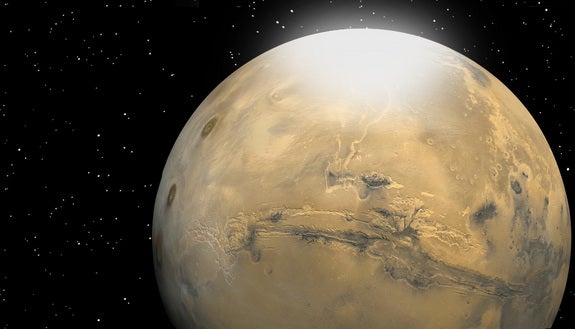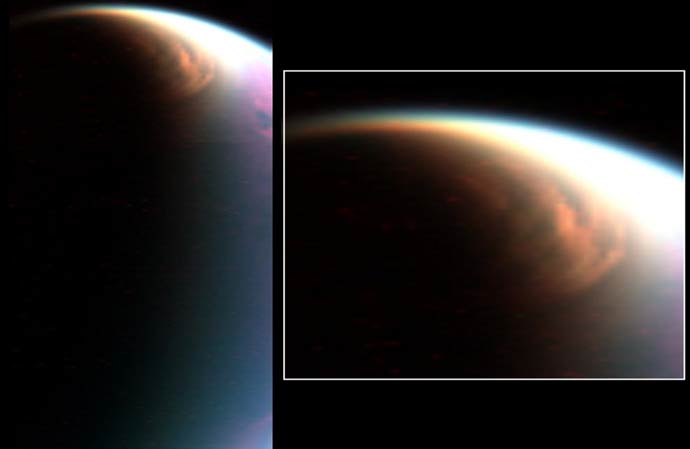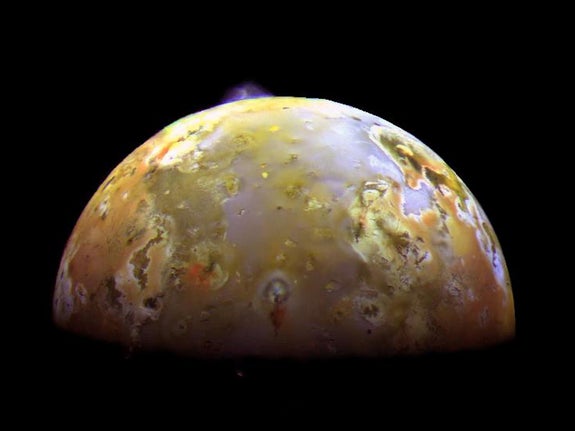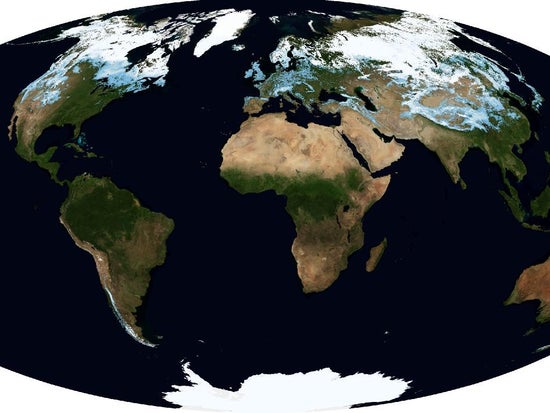This article was published in Scientific American’s former blog network and reflects the views of the author, not necessarily those of Scientific American
Plutophiles are abuzz over the New Horizons spacecraft’s observations of the object formerly known as the ninth planet. As the ship approached Pluto on July 13, it snapped the best shot of the dwarf planet yet, revealing previously unseen surface features that, according to NASA scientists, suggest Pluto is home to a rare weather phenomenon: snow.
Because Pluto is a frigid body with an icy surface, one might expect Pluto to host the occasional snowstorm. But cold temperatures and frozen materials do not a snowy planet make. In order to have frozen material fall from the sky, a planet needs either an atmosphere that can host snow clouds or volcanic eruptions that can launch freezable material high enough. It also needs a solid surface for that snow to land on, explains planetary scientist Bruce Betts of the Planetary Society. Few objects in the outer solar system meet these requirements. But Pluto, which has a thin nitrogen atmosphere with the potential for producing snow, might just be one of them.
When asked during a press conference if the new image confirms that it’s snowing on Pluto, Alan Stern, NASA’s principal investigator on the New Horizons mission, simply replied, “It sure looks that way.” A somewhat awkward silence ensued, during which the audience clearly thought he would elaborate. He didn’t, but New Horizons should confirm suspicions of snow soon enough. During New Horizons’ closest encounter with Pluto on July 14, the spacecraft was temporarily out of touch with Earth so that it could fous all its attention on collecting data, but over the next several months that data will start flooding back to NASA scientists. If it is snowing on Pluto, the dwarf planet joins a very exclusive club: snow of various weird kinds falls on only a handful of planets and moons across the solar system.
On supporting science journalism
If you're enjoying this article, consider supporting our award-winning journalism by subscribing. By purchasing a subscription you are helping to ensure the future of impactful stories about the discoveries and ideas shaping our world today.
Mars

Artist's impression of snow falling in fine mist over Martian surface
Credit: NASA, Christine Daniloff/MIT
In the dead of winter, the poles of the Red Planet experience distinct forms of snowfall. Snow composed of H2O falls in the north; dry ice snow (frozen carbon dioxide) blankets the south. While trundling around Mars’ northern planes in September 2008, NASA’s Phoenix Mars Lander spotted water snow in Martian clouds a couple of miles high, though the snow vaporized before it reached the ground. On the other side of the planet dry ice snow actually sticks. Scientists knew for decades that the ice cap coating Mars’ south pole, which grows and shrinks with the seasons, contained a dry ice. But no one was quite sure how it got there until 2012, when researchers sifting through old Mars Reconnaissance Orbiter data discovered carbon dioxide snow clouds hovering over the Red Planet, says Angela Zalucha, a planetary scientist at the SETI Institute. The fine particles of dry ice snow on Mars are much smaller than the flakes that fall on Earth—only about as big as human red blood cells. In fact, an observer on Mars would see something less like snow fall and more like snow fog. Scientists have simulated Martian carbon dioxide snow flakes and found that they have a “cubohedral shape,” which basically means they look like tiny cubes with the corners cut off. If you scooped up a handful of Martian snow, it would probably have a consistency like cornstarch.
Titan

Cloud over the north pole of Titan
Credit: NASA/JPL/University of Arizona/LPGNantes
In many ways, Saturn’s moon Titan is a lot like our home planet: many of the processes that govern Earth’s geology and climate such as wind, volcanism and tectonic activity are also at work on Titan. What’s more, Titan is the only other celestial body known to host pools of liquid on its surface. Titan is enveloped in an atmosphere and, like Earth, it experiences a process of evaporation and precipitation. But the moon is so frigid— temperatures there average -180 degrees Celsius (-292 Fahrenheit)—that its water can only exist on the moon’s surface in the form of deep-frozen ice as strong as rock. Titan’s lakes and clouds are filled with methane, however, which has a much lower freezing point than water does. Methane vapor rises to layers of cooler and cooler temperature in Titan’s atmosphere until it falls as either rain or snow, blanketing the hills and mountains on the moon’s surface.
Io

Io ejecting a bluish plume of material from a volcanic caldera known as Pillan Patera
Credit: Galileo Project, JPL, NASA
Jupiter’s moon Io is constantly squeezed and flexed by the immense gravitational tug of its host planet—an occupational hazard of orbiting a gas giant with such an intense gravitational field. Consequently, Io’s interior is hot enough to fuel rampant volcanism all over its surface. Vents spew umbrella-shaped plumes containing sulfur dioxide hundreds of miles above the moon’s surface. This volatile material may be molten when it’s broiling below ground, but sulfur dioxide freezes solid at the frigid temperatures that prevail on Io’s surface, so it rains down from the plume as frozen crystals similar to snowflakes. In 2000, NASA’s Galileo spacecraft returned images of Io’s plains covered in what appeared to be white snow. A few months later, Galileo was zooming past Io’s north pole when it met with a sudden blast of sulfur snowflakes that erupted from a previously unknown volcano there. Fortunately for NASA scientists, Galileo getting caught in a surprise snowstorm meant that the spacecraft had a new sample of volcanic material to study.
Earth

Credit: NASA
Of course, we couldn’t talk about snow in the solar system without mentioning Mother Earth. Compared to the exotic substances falling from the skies of other planets and moons, our own water snow might seem a bit bland. But snow composed of H2O is actually pretty special, as snow goes: water is almost unique in that it’s denser as a liquid than a solid. This rare property is what allows ice cubes to float in your glass of water, and what allows us to squeeze together snowballs for backyard combat or snowman construction. In fact, ours is the only good packing snow in the solar system. So if you were looking forward to epic dry ice snowball fights when humans eventually make their way to Mars, sorry to disappoint.